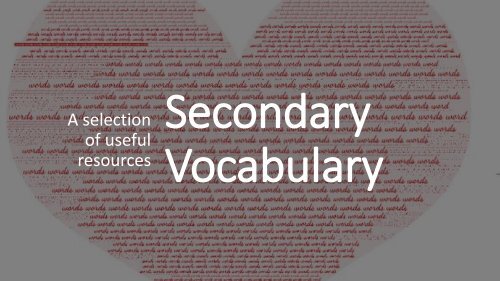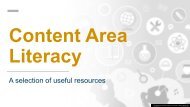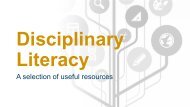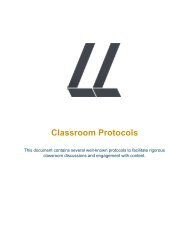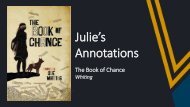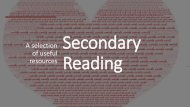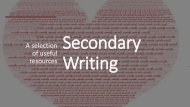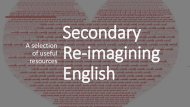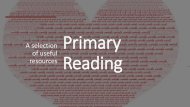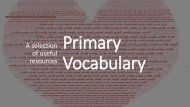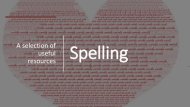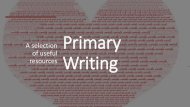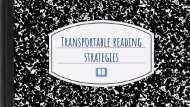Secondary - Vocabulary Magazine 2021
Create successful ePaper yourself
Turn your PDF publications into a flip-book with our unique Google optimized e-Paper software.
A selection<br />
of useful<br />
resources<br />
<strong>Secondary</strong><br />
<strong>Vocabulary</strong>
Bringing Words to Life:<br />
Robust <strong>Vocabulary</strong> Instruction<br />
Beck, McKeown & Kucan (2013)<br />
A very influential and practical book on teaching and developing<br />
vocabulary.<br />
This second edition is even more comprehensive than the first. It<br />
includes - vocabulary and writing; assessment; differentiated<br />
instruction for struggling readers and EAL students; discussions<br />
of content-area vocabulary and multiple meaning words;<br />
additional examples of what robust instruction looks like in<br />
action, and a useful menu of instructional activities.<br />
Beck, McKeown & Kucan are trusted experts and share their<br />
decision making, offer warnings about potential challenges,<br />
encourage thoughtful planning, and insist on follow-through.<br />
2013 – Second Edition<br />
This personal touch is perhaps the most distinctive feature of<br />
this book.
<strong>Vocabulary</strong> Games for<br />
the Classroom<br />
Carleton & Marzano (2010)<br />
Carleton and Marzano have devised a way to make learning vocabulary<br />
enjoyable and easy for students through a simple, straightforward and<br />
easy to use resource, <strong>Vocabulary</strong> Games for the Classroom. In this book<br />
they provide a rich variety of vocabulary games aimed at building and<br />
reinforcing students’ academic and general vocabulary.<br />
Tailored for Foundation to Year 12 teachers.<br />
Each activity includes a description of:<br />
• the targeted year levels and content area<br />
• the design<br />
• set-up<br />
• materials<br />
• step-by-step instructions<br />
Extensive appendix with hand picked vocabulary terms
Tools for Teaching<br />
Academic <strong>Vocabulary</strong><br />
Allen (2014)<br />
This is a toolkit for teaching vocabulary. It provides strategies that<br />
will help students learn new words, become more conscious of<br />
words, and increase their competence in knowing when and how to<br />
use words.<br />
To help develop effective vocabulary instruction, Allen has divided<br />
the resource into four components:<br />
• Providing rich and varied language experiences, Teaching<br />
individual words, Teaching word-learning strategies and<br />
Fostering word consciousness.<br />
Allen further offers tools to develop effective instruction for each<br />
component. Each activity description includes:<br />
1. What the strategy is?<br />
2. How is could be used in the classroom?<br />
3. When/ why to apply the strategy?
<strong>Vocabulary</strong>: Integrated Word<br />
Study in the Middle Grades<br />
Overturf (2015)<br />
Vocabularians is an instructional and practical book that guides<br />
teachers to support adolescents to increase knowledge and<br />
competency with word study, and to provoke the love of<br />
words.<br />
A list of strategies and practical examples are presented that<br />
have been crafted by creative teachers.<br />
These strategies and activities include:<br />
• <strong>Vocabulary</strong> Activities with an Art Focus<br />
• <strong>Vocabulary</strong> and Dramatic Expression<br />
• <strong>Vocabulary</strong> Activities Immersed in Music<br />
• <strong>Vocabulary</strong> Practice with Games<br />
• <strong>Vocabulary</strong> Activities with Poems, Puzzles and Writing<br />
• <strong>Vocabulary</strong> with Media and Technology<br />
• Making Words Come Alive
<strong>Vocabulary</strong> Their Way:<br />
Word Study with Middle and<br />
<strong>Secondary</strong> Students<br />
This book offers invaluable tools for teachers to use that will<br />
enable their students to learn thousands of words<br />
independently. The emphasis is on building word<br />
consciousness. This new edition addresses three broad aspects<br />
of vocabulary learning and instruction: context-based<br />
instruction, word-specific instruction and generative<br />
morphology instruction, and is available for pre-service,<br />
graduate and experienced teachers of middle primary and high<br />
school students.<br />
Templeton, Bear, Invernizzi, Johnston, Flanigan, Townsend, Helman &<br />
Hayes (2014)
Inside Words:<br />
Tools for Teaching<br />
Academic <strong>Vocabulary</strong><br />
This book provides practical strategies and activities for teaching<br />
vocabulary. Allen shows teachers how to help students<br />
understand academic vocabulary found in texts books, texts,<br />
articles and other informational texts. Allen has merged recent<br />
research and key content-area teaching strategies.<br />
These are organised into the following categories:<br />
• Builds background knowledge<br />
• Teaches words that are critical to comprehension<br />
• Provides support during reading and writing<br />
• Develops conceptual framework for themes, topics, and<br />
units of study<br />
• Assesses students understanding of words and concepts<br />
Allen (2007)
Creating Robust <strong>Vocabulary</strong><br />
Beck, McKeown & Kucan (2018)<br />
Creating Robust <strong>Vocabulary</strong> by Beck, McKeown and Kucan<br />
builds onto their ground-breaking work in Bringing Words to<br />
Life.<br />
This volume delivers thoroughly researched, evidence-based<br />
strategies for supporting vocabulary development and<br />
presents them in a way that is accessible to teachers and<br />
engaging to students.<br />
Content includes:<br />
• Practical questions, extended examples, additional<br />
tools and tips, details about effective instruction,<br />
working with EAL students and professional<br />
development.
Teaching Basic, Advanced<br />
and Academic <strong>Vocabulary</strong><br />
Marzano (2020)<br />
The resource will help students learn a tiered<br />
vocabulary.<br />
Contents include:<br />
• The Importance of <strong>Vocabulary</strong> Knowledge<br />
• Teaching and Reinforcing Tier One and Tier<br />
Two Terms as a Schoolwide Effort<br />
• Tier One and Tier Two Terms for Individual<br />
Students<br />
• Teaching Tier Three Terms
Building Academic <strong>Vocabulary</strong>:<br />
Teacher’s Manual<br />
Marzano & Pickering (2005)<br />
A great resources to give teachers a practical way to<br />
help students master academic vocabulary. Building on<br />
from their previous book, Marzano and Pickering<br />
provide ideas and suggested word lists for<br />
implementing subject specific vocabulary instruction.<br />
With word lists applicable for F-12, educators are<br />
encouraged to use the provided tools and activities to<br />
help their students deepen their own understandings of<br />
academic vocabulary, while helping them master<br />
essential vocabulary and concept areas in each<br />
discipline.
No More “Look Up the List”<br />
<strong>Vocabulary</strong> Instruction<br />
Cobb & Blachowicz (2014)<br />
This useful and quick read is an efficient guide to engaging<br />
research-proven practices for teaching words effectively.<br />
Cobb & Blachowicz share why old practices don’t work and<br />
how to put research into action. They answer the most<br />
commonly asked questions about vocabulary instruction,<br />
including:<br />
• How many words, and how do I select them?<br />
• How can I foster student independence using<br />
dictionaries and glossaries?<br />
• How do I find time for meaningful vocabulary<br />
instruction?<br />
• How can I assess and hold students accountable?
Teaching <strong>Vocabulary</strong> in All<br />
Classrooms<br />
The 5th Edition of Teaching <strong>Vocabulary</strong> in All Classrooms,<br />
offers teachers ideas for implementing best-practice<br />
vocabulary research and classroom-tested strategies into<br />
their everyday classroom instruction.<br />
A theoretical and practical perspective is presented.<br />
Content areas:<br />
• Learning in context, English focuses, Content area<br />
focuses, Connections to spelling, Assessment,<br />
Instruction for diverse learners and Developing word<br />
consciousness.<br />
Blachowicz & Fisher (2015)
Words Their Way:<br />
Word Study for Phonics,<br />
<strong>Vocabulary</strong> and Spelling Instruction<br />
Offers a systematic, teacher-directed, childcentered<br />
plan that provides a complete<br />
word study curriculum to motivate and<br />
engage students while helping them to<br />
succeed in literacy learning.<br />
Bear, Invernizzi, Templeton & Johnston (2014)
<strong>Vocabulary</strong> in a Snap:<br />
100+ Lessons <strong>Secondary</strong><br />
Instruction<br />
<strong>Vocabulary</strong> in a Snap is a teacher’s treasure chest<br />
full of excellent, user-friendly strategies that<br />
replace simply defining words with elevating<br />
practice using rich application and transfer.<br />
Access 100+ effective, practical, and fun vocabulary<br />
exercises that take 20 minutes or less. Peery’s<br />
outstanding SNAP lessons are aimed to help you<br />
increase vocabulary for your high school and<br />
middle school students.<br />
Peery (2018)
Closing the <strong>Vocabulary</strong> Gap:<br />
Mind the Gap<br />
Quigley explores the increased demands of<br />
an academic curriculum and how closing<br />
the vocabulary gap between ‘word poor’<br />
and ‘word rich’ students could prove the<br />
vital difference between school failure and<br />
success. This book provides practical<br />
solutions for teachers across the<br />
curriculum, incorporating easy-to-use tools,<br />
resources and classroom activities.<br />
Quigley (2018)


